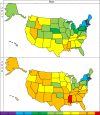Physician workforce in the United States of America: forecasting nationwide shortages
- PMID: 32029001
- PMCID: PMC7006215
- DOI: 10.1186/s12960-020-0448-3
Physician workforce in the United States of America: forecasting nationwide shortages
Abstract
Background: Physicians play a critical role in healthcare delivery. With an aging US population, population growth, and a greater insured population following the Affordable Care Act (ACA), healthcare demand is growing at an unprecedented pace. This study is to examine current and future physician job surplus/shortage trends across the United States of America from 2017 to 2030.
Methods: Using projected changes in population size and age, the authors developed demand and supply models to forecast the physician shortage (difference between demand and supply) in each of the 50 states. Letter grades were then assigned based on projected physician shortage ratios (physician shortage per 100 000 people) to evaluate physician shortages and describe the changing physician workforce in each state.
Results: On the basis of current trends, the number of states receiving a grade of "D" or "F" for their physician shortage ratio will increase from 4 in 2017 to 23 by 2030, with a total national deficit of 139 160 physician jobs. By 2030, the West is forecasted to have the greatest physician shortage ratio (69 physician jobs per 100 000 people), while the Northeast will have a surplus of 50 jobs per 100 000 people.
Conclusion: There will be physician workforce shortages throughout the country in 2030. Outcomes of this study provide a foundation to discuss effective and efficient ways to curb the worsening shortage over the coming decades and meet current and future population demands. Increased efforts to understand shortage dynamics are warranted.
Keywords: Demand; Physician shortage; Physician workforce; Report card; Supply.
Conflict of interest statement
The authors declare that they have no competing interests.
Figures


References
-
- Abrams M, Nuzum R, Mika S, Lawlor G. Realizing health reform’s potential: how the affordable care act will strengthen primary care and benefit patients, providers, and payers. New York: The Commonwealth Fund; 2011. - PubMed
-
- The Bureau of Labor Statistics. Occupational Outlook Handbook. Retrieved from https://www.bls.gov/ooh/home.htm. Accessed on Oct 15, 2018.
-
- U.S. Department of Health and Human Services . State-level projections of supply and demand for primary care practitioners: 2013-2025. Rockville, MD: National Center for Health Workforce Analysis; 2016.
-
- Carrier ER, Yee T, Stark LB. Matching Supply to Demand: Addressing the U.S. Primary Care Workforce Shortage. National Institute For Health Care Rreform (NIHCR) Policy Analysis [Internet]. 2011; No. 7: [pp. 1–7]. Retrieved from https://www.nihcr.org/wp-content/uploads/2016/07/Policy_Analysis_No._7.pdf. Acccessed 4 Feb 2020.
MeSH terms
LinkOut - more resources
Full Text Sources

